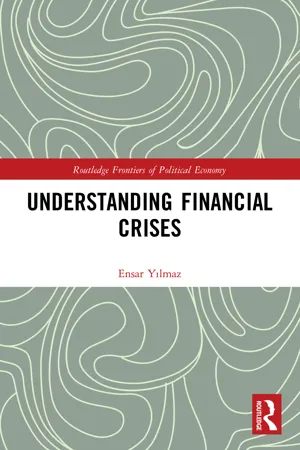
- 232 pages
- English
- ePUB (mobile friendly)
- Available on iOS & Android
Understanding Financial Crises
About this book
Incorporating a broad range of economic approaches, Understanding Financial Crises explores the merits of various arguments and theories which have been used to explain the causes of financial crises. The book explores eight of these different explanations: underconsumption, debt accumulation, financialization, income inequality, financial fragility, tendency of rate of profit to fall, human behavior, and global imbalances. The introduction provides a brief overview of each argument along with a comparison of their relative merits. Each chapter then introduces one of the arguments, explores a historical case, and focuses on the insights that can be gleaned into the global crisis in 2007–2008. The book draws on insights from various schools of thought including post-Keynesian economics, Marxist economics, behavioral economics, neoclassical economics, and more, to provide a pluralist overview of the causes of economic crises in general and the Great Recession in particular. This book marks a significant contribution to the literature on economic and financial crises, political economy and heterodox economics. It is well suited to academicians, practitioners, and financial analysts working within the relevant fields.
Frequently asked questions
- Essential is ideal for learners and professionals who enjoy exploring a wide range of subjects. Access the Essential Library with 800,000+ trusted titles and best-sellers across business, personal growth, and the humanities. Includes unlimited reading time and Standard Read Aloud voice.
- Complete: Perfect for advanced learners and researchers needing full, unrestricted access. Unlock 1.4M+ books across hundreds of subjects, including academic and specialized titles. The Complete Plan also includes advanced features like Premium Read Aloud and Research Assistant.
Please note we cannot support devices running on iOS 13 and Android 7 or earlier. Learn more about using the app.
Information
Table of contents
- Cover
- Half Title
- Series Information
- Title Page
- Copyright Page
- Dedication
- Table of Contents
- List of Figures
- List of Tables
- Acknowledgment
- Introduction
- Chapter 1 Underconsumption, overproduction, and disproportionality
- Chapter 2 Debt accumulation
- Chapter 3 Financialization and neoliberalism
- Chapter 4 Income inequality
- Chapter 5 The financial instability hypothesis
- Chapter 6 Tendency of rate of profit to fall
- Chapter 7 Human behavior
- Chapter 8 Global imbalances and crises
- Bibliography
- Index